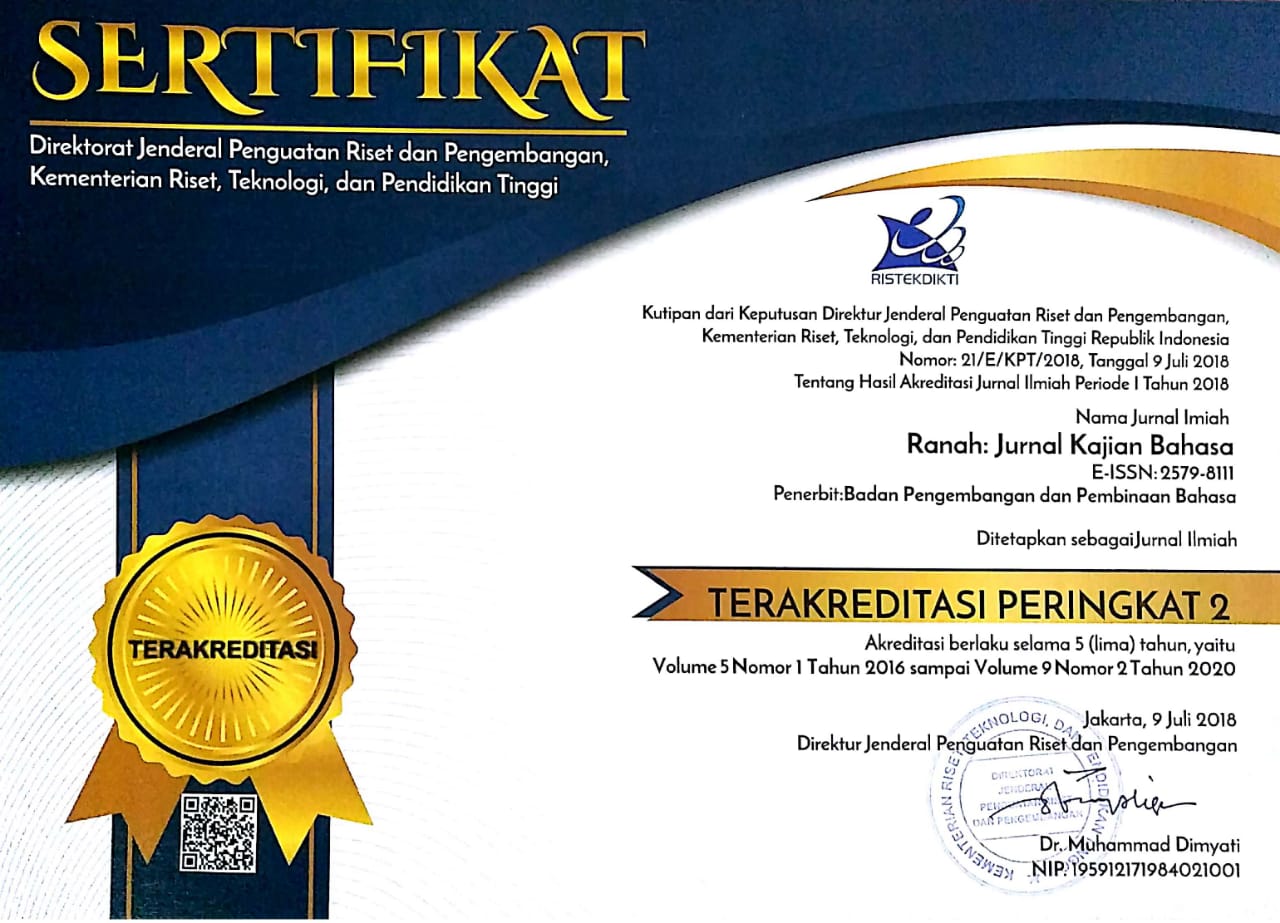Code Switching as Interlanguage Communication Strategy by Indonesian EFL Learners
Abstract
This study was aimed at exploring the use of code switching (CS) as interlanguage communication strategy by EFL students when they were communicating in English. Particularly, this study tried to describe the patterns of CS as communication strategy and factors that contributed to the use of the CS as communication strategy by the EFL learners. It was a qualitative research using 30 students of one of Junior High School in Surakarta as research subjects. The data were collected through elicitation technique in which the research subjects were given a task to describe a cartoon. Their utterances were recorded and used as primary data source. Utterances that contained CS were identified and used as primary data. The data were analyzed qualitatively by inductive techniques, using Dornyei and Myers-Scotton analysis frameworks. The research findings were then interpreted based on relevant theory. The results showed that the students used three types of CS, namely tag code switching, intra-sentential code switching and inter-sentential code switching. Three factors identified as the reasons of the use of CS as communication strategy were bilingual, limited mastery of English and as a compensation strategy. It can be concluded that the use of CS by EFL learners is a natural and unavoidable phenomenon since this represents one of the communication strategies to compensate for the EFL learners' limited mastery of the target language they are learning.
Abstrak
Penelitian ini bertujuan untuk mengeksplorasi penggunaan alih kode sebagai strategi komunikasi bahasa antar pembelajar bahasa Inggris di Indonesia. Secara khusus, penelitian ini bertujuan untuk mendeskripsikan pola alih kode dan faktor yang berkontribusi pada penggunaan alih kode tersebut sebagai strategi komunikasi oleh pembelajar bahasa Inggris. Jenis penelitian ini adalah kualitatif dengan subjek penelitian 30 siswa dari salah satu SMP di Surakarta. Pengumpulan data dilakukan dengan teknik elisitasi, yang dilakukan dengan memberikan tugas kepada subjek penelitian untuk mendeskripsikan sebuah kartun. Ucapan mereka direkam dan digunakan sebagai sumber data primer. Ucapan yang mengandung alih kode diidentifikasi dan digunakan sebagai data primer. Data dianalisis secara kualitatif dengan teknik induktif yang menggunakan kerangka analisis Dornyei & Myers-Scotton. Temuan penelitian kemudian diinterpretasikan berdasarkan teori yang relevan. Hasil penelitian menunjukkan bahwa siswa menggunakan tiga jenis alih kode, yaitu alih kode tag, alih kode intrasentensial, dan alih kode antarsentensial. Tiga faktor yang berkontribusi terhadap penggunaan alih kode tersebut adalah kedwibahasaan, penguasaan bahasa Inggris yang terbatas, dan sebagai strategi kompensasi. Dapat disimpulkan bahwa penggunaan alih kode oleh pembelajar bahasa Inggris merupakan fenomena alami dan tidak dapat dihindari dalam pembelajaran bahasa Inggris sebagai bahasa asing. Hal ini merupakan salah satu strategi komunikasi untuk mengompensasi keterbatasan penguasaan bahasa sasaran.
Keywords
Full Text:
PDFReferences
Andayani, T. (2014). Code-switching, a communication strategy in learning English. Proceedings of the ISELT-4. ejournal.unp.ac.id›index.php›selt›article›download
Appel, R., & Muysken, P. (2006). Language Contact and Bilingualism. Amsterdam University Press: Amsterdam. https://doi.org/10.5117/9053568573
Brown, H. D. (2000). Principles of language learning and teaching (4th Ed.). New York: Addison Wesley Longman, Inc.
Canale, M & Swain, M. (1980). Theoretical bases of communicative approaches to second language teaching and testing. Applied Linguistics, 1, 1-47. https://doi.org/10.1093/applin/1.1.1
Celce-Murcia, M. (ed.) (1995). Teaching English as a second or foreign language (2nd ed.). Boston, Massachusetts: Heinle & Heinle Publishers.
Chung, H. H. (2006). Code switching as a communicative strategy: A case study of Korean-English bilinguals. Bilingual Research Journal .30(2), 293-307. https://doi.org/10.1080-/15235882.2006.10162878
Dornyei, Z., & Scott, M. L. (1997). Communication strategies in a second language definitions and taxonomies. Language Learning. 47, 173-210. https://doi.org/10.1111/0023-8333.51997005
Ellis, R. (2006). The study of second language acquisition. Oxford, England: Oxford University Press.
Grainger, P. R. (2010). Spoken communication strategies used by learners of Japanese in a foreign language learning environment. Unpublished Thesis, University of Queensland, Australia. Retrieved from https://www.researchgate.net/publication/277013435_
Grosjean, F. (2008). Studying bilinguals. Oxford, England: Oxford University Press.
Hoffman, Ch. (1991). An Introduction to bilingualism. London: Longman
Lai, H. (2010).Gender effect on the use of CSs. ELT English Language Teaching. 3(4), 28-32. https://doi.org/10.5539/elt.v3n4p28
Myers-Scotton, C. (1993). Social motivations for code switching. Evidence from Africa. Oxford: Clarendon Press.
Metcalfe, J. & Ura, S. N. (2013). Communication strategy use of high and low proficiency learners of English at a Thai University. LEARN Journal. 6(1), 68-89.
Moore, D. (2010) Code-switching and learning in the classroom. International Journal of Bilingual Education and Bilingualism 5(5), 279-293. https://doi.org/10.1080/13670050208667762
Muysken, Pieter (2000): Bilingual Speech. A Typology of Code-Mixing. Cambridge: CUP.
Nyambura, N. G. (2015). Code-switching as a communication strategy in secondary schools: A case study of St. Francis girls' High School, Mang'u. Thesis retrieved from http://erepository.uonbi.ac.ke/bitstream/handle/11295/95001/Ngugi_Code-switching
Oxford, R. (2003). Language learning strategies: An overview. Proceedings of GALA 2003 (Generative Approaches to Language Acquisition) Volume 1.
Rubin, J., & Thompson, I. (1994) How to be a more successful language learner. Boston, MA: Heinle & Heinle Publishers
Schmidt, A. (2014). Between the languages: Code-switching in bilingual communication. Hamburg: Anchor Academic Publishing.
Tarone, E. (1981). Some Thoughts on the Notion of Communication Strategy.TESOL Quarterly 15, 285-295. https://doi.org/10.2307/3586754
Tarone, E. (1981). Some thoughts on the notion of communication strategy. TESOL Quarterly, 15 (3), 285-295. https://doi.org/10.2307/3586754
Thomas, D. R. (2006). A General Inductive Approach for Analyzing Qualitative Evaluation Data. American Journal of Evaluation 27(2), 237-247. https://doi.org/10.1177/1098214005283748
Selinker, L. (1997). Rediscovering interlanguage. London: Longman.
DOI: https://doi.org/10.26499/rnh.v9i2.2950
Refbacks
- There are currently no refbacks.








